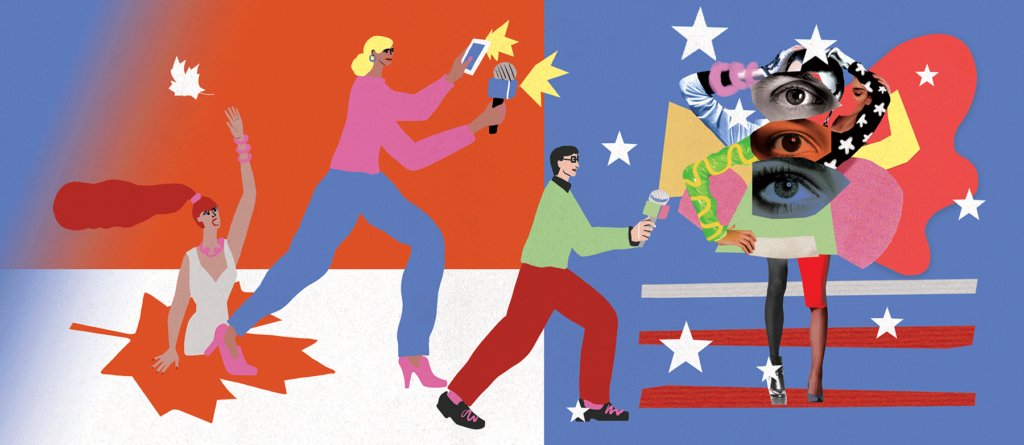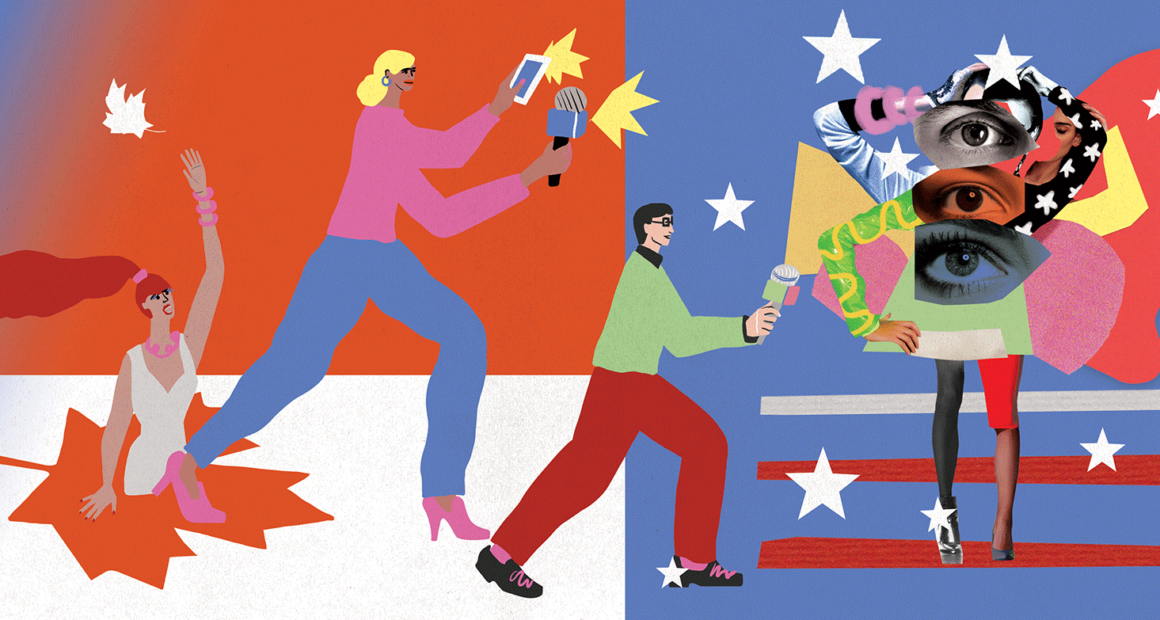Canadian fashion journalists tell international stories, not their own

It’s a chilly weekend in November 2024, but outside T3 Bayside, the crisp air is charged with excitement. Crowd control bollards funnel guests—hundreds of homegrown designers, models, photographers, artists, and fashion lovers—into the runway room, where they await the chance to see the new collections and mingle among art and clothing. Bursts of colour, texture, and personality transform this east downtown Toronto space on the waterfront. T3 Bayside, which boasts the title of tallest timber office building in North America, is hosting 8,000 attendees and participants at Fashion Art Toronto, a four-day annual celebration of Canadian fashion. This weekend, the event is debuting fall and winter fashions, showcasing more than 40 Canadian designers.
Guests are flashed by cameras as they flaunt their Sunday best, graced with feathers, fur, sequins, and accessories. Here, the term “ordinary” is thrown out the window. Stilt walkers tower over the front row and strut the runway. It’s a bold, lively atmosphere.
Although entire fashion communities and subcultures exist in Canada, the individuals and creators within these spaces often lack media coverage despite the efforts of organizations like Fashion Art Toronto (FAT) to showcase talent. Vanja Vasic, director of FAT, launched the event in 2005 with a vision—she wanted a space that could intersect fashion and art with culture and identity in an inclusive way. “I wanted to explore what the fashion scene was like in Canada,” Vasic says, “and let people who are working from the underground have a space to explore those ideas.”
The event features all-Canadian retail boutiques, exhibitions, and installations, along with recurring immersive fashion playground presentations. In 2023, Adrian Ally’s otherworldly characters from the fictional planet Martianally interacted with the audience from atop a platform. Designer Meesh presented her collection made from denim scraps, with models doing interpretive movements to the sounds of pouring rain.
FAT highlights the diversity and creativity of local talent, alongside other domestic initiatives like Indigenous Fashion Arts, RunwayTO, RCHIVE, and the Toronto Plus Size Fashion Show. Meanwhile, traditional fashion news in Canada focuses mainly on New York City and other international scenes.
The Canadian Arts and Fashion Awards (CAFA), launched by Vicky Milner, is another effort to celebrate and foster the Canadian fashion industry. This year’s show recognized Vasic’s achievements by presenting her with the Fashion Impact Award. She says she started the event “as an alternative and a bit against the grain,” so being recognized by the industry nearly 20 years after its launch is both a personal validation as well as an acknowledgement of the event’s importance.
The CAFA ceremony is the most reported event in Canadian fashion, even grabbing the attention of international media. Although the coverage is welcome, the reporting often overlooks the diversity and innovation that define the creative landscape in Canada. Domestically, CBC published “Top Fashion Designers Crowned at Canadian Arts & Fashion Awards,” spotlighting already prominent Canadian designers Beaufille and Spencer Badu in the display copy—but that was about it.
Elle Canada was not even that extensive—its article simply listed the 2024 CAFA nominations. “The time has come once again to celebrate homegrown style and talent,” it says, failing to actually discuss that homegrown talent. Despite the CAFAs occurring a month before FAT, a scan of Canadian outlets yields little coverage of the event. Phrases such as “Canada fashion” or “Canadian designer” hardly trigger search engines to cough up anything close to what is happening in Canadian fashion. While Taylor Swift’s Eras Tour made its way onto the dropdown menu of the Toronto Star’s webpage, alongside visual arts, music, and television, there never seems to be space for fashion. Similarly, The Walrus does not consider fashion to be of interest to its readers. Their arts and culture section comprises visual arts, film, and music, among others—but there is no hyperlink to fashion stories. “These spaces are not necessarily covering that scene and what’s happening,” Vasic says.
Lora Grady, a freelance beauty and fashion journalist, says that Canadian media and journalism have a longstanding history of fashion coverage. She fondly recalls the days of Fashion Television (FT), which aired from 1985 to 2012. “I remember sitting on the couch with my mom, and the music would start,” says Grady. “You would be like, ‘Here comes Jeanne Beker!’” Canadian media included other programs like CBC’s Fashion File, hosted by Tim Blanks, and publications such as Glow and Lou Lou catered to the fashion-curious but have since been shuttered.
In 2010, Odessa Paloma Parker, a design-and-art-focused editor, journalist, and stylist, launched Plaid with her husband. The magazine covered local musicians and artists but primarily focused on people in fashion. Parker was passionate about the arts and exposing readers to new talent. “I felt like even the big Canadian fashion publications were not paying attention to local talent. It was always the same designers you would see, and the coverage often felt tokenized,” she says. After a three-year run, Plaid was forced to shut down, yet Parker still writes about local arts communities on her website, Opaloma. Plaid existed alongside other Canadian magazines that prioritized local creativity, Parker remembers. She says, “I can’t help but wonder if we all came together and had just done one?”
Cities such as New York or London spotlight their underground creative communities on an international level. From beauty to fashion, to film, to visual art, “there’s really a culture of celebrating the underground as sort of a core tenet of the city’s ethos and its identity,” says Cody Rooney, editor in chief of Liminul in Toronto. “There are other cities across the world that are so hospitable to artists—they have the publications that are giving emerging artists visibility.” Rooney believes that creative talent is abundant in Canada but is frustrated by the underwhelming support for Canadian artists, designers, and creatives. “I don’t think there’s really a culture of celebrating talent in the way that it should be.”
“We need to amplify our designers locally. If our own media is not interested, who’s it going to be then?”
Annika Lautens
As with Parker, Rooney recognized a gap. During the pandemic, he and a friend launched Liminul, a digital Canadian media network intended to showcase creatives from Toronto and Montreal to an international audience. “I feel like people are hungry for something that represents community,” he says, envisioning a platform that marries his love of visual culture and fashion with media.
Some of Canada’s largest fashion publications, such as Elle Canada and FASHION, are dedicated to their craft, but their reporting on Canadian designers and runway milestones is inconsistent. Many stories are internationally focused rather than domestic, raising concerns about why Canada’s fashion publications don’t prioritize their own content. “There’s so much talent in Canada,” says Annika Lautens, fashion news and features director at FASHION, suggesting this can sometimes create a disconnect between covering events and talent.
Despite the conversations being had amongst the masthead and efforts made to promote Canadian creativity wherever possible, it is ultimately a problem out of their control. In comparison to the golden age of fashion journalism, when brands competed for ad placement, magazines now pitch themselves to brands and must prove they are a worthwhile investment. This problem is not specific to Canadian fashion magazines or even Canadian magazines in general—it’s the industry of long-form print journalism.
The fact that fashion coverage is almost entirely dictated by advertisers limits the opportunity to take risks with promotion and exposure. It’s an uneven teeter-totter, with one side promoting Canadian creatives and designers while the other holds the weight of advertiser influence. To keep your advertisers happy, Lautens says, “you need to prioritize their coverage—and you need to prioritize their content.”
Even though Canada’s fashion industry may not have the upper hand against advertisers, “we’re constantly looking at ways of how to find that right balance of promoting our talent and reporting on pop culture,” Lautens says. Although they haven’t quite found the magic formula just yet, FASHION is happy to be a partner of FAT. “That’s definitely an initiative that we’re super proud of,” says Lautens. “We’re hoping we can continue shifting the scales more to continue promoting more Canadians.”
Trying to establish a cultural identity while so close to the American colossus is perennially difficult. “Canada is possibly too humble for its own good,” Lautens says. Canadian talent and creativity are clearly present, she thinks, but they sometimes go unrecognized by Canadians themselves, requiring a stamp of approval from other countries before Canadians pay attention. Vasic agrees: “We need to amplify our designers locally and have that confidence in our own stories so that others can be interested in it, too. If our own media is not interested, who’s it going to be?”
Looking forward, Bernadette Morra, former editor in chief of FASHION, believes we are seeing a shift in media. Coverage has historically cast a wide net over topics for a broader audience, but now, the reverse is true. Morra says “narrowly focused points of view and voices that are building strong audiences” are desired now. “All you have to do is look and see the individuals who are building a strong audience.”
It’s a push that’s already being seen in the food industry through the farm-to-table movement. “People are now more interested in who is making what they want to buy,” Morra says. “There’s more support towards independent designers.” But the motivation isn’t there yet, which she thinks “hinders the amount of coverage that there is for independent designers.”
To succeed in this reporting, “the priorities should be people coming together, having conversations like this,” Parker says, to address the problem of well-rounded communities that are not only lacking in the Toronto fashion scene but also in art, music, and culture. “It’s really a cultural death that we’re experiencing right now—fashion may have been first, but fashion was always feeling like the lowest priority, frankly, in terms of cultural activity here.”
Rooney believes that what starts with the creative community will trickle down and interest younger generations. “They feel the pulse of what we’re trying to build,” he says as platforms like FAT and RCHIVE elevate experiences. “It’s just a matter of also melding the creative undergrounds with established brands and artists that might be more known internationally and bringing them all together,” Rooney says. “This is the ethos of Canadian culture and creativity.”
About the author
Neda Madany is in her final year of the Bachelor of Journalism program at TMU, where she is also completing a minor in Fashion Studies. Interested in fashion and art storytelling, Neda is currently Co-Director of Podcasts at StyleCircle and a writer for HUES and Her Campus in Toronto.





